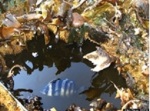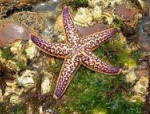Have you forgotten all about the tsunami that devastated Japan in 2011? Then you don’t live on the coast of Oregon or Washington! Amazing things continue to show up on the beaches.
At the end of March 2013, an 18-foot (5.5 meter) skiff washed ashore. Nothing unusual aboutthat, lots of boats have landed on the beaches of the west coast. This particular boat however, contained the equivalent of a 30 gallon fish tank (a bait box) with a flourishing ecosystem. The box contained seaweed, a sea cucumber, algae, sea worms, barnacles, blue mussels, crabs, scallops, and most amazing of all 5 Beakfish.
This is the first time a vertebrate has been found it the debris, and they sent scientists scurrying to once again revise their estimates of what might wash ashore. Immediately after the tsunami scientists speculated that no species could survive the trip across the ocean. When the two large docks landed, one each in Oregon and Washington, it was obvious that many could and did survive. However scientist thought that only thinks that were at least partially submerged before the tsunami would have life attached to them. The debris that has washed in shows that larva found in the water will attach to anything.
More debris than ever seems to be washing up. Since early February at least one boat per week has been found. Most of the species that have been attached to things have been benign. However some have the potential to disrupt our coastal environment. Ship worms if they became established would harm wooden docks and possibly even the coastal forest. Wakame, an aggressively invasive of seaweed, has turned up on several occasions, and the beautiful purple and cream
North Pacific Sea Star has also been found. The North Pacific Sea Star is on the 100 of the World’s Worst Invasive Alien Species list. The diet of this star includes nearly anything it finds. It is especially problematic to mariculture (farming of ocean life) such as the oyster beds in Oregon and Washington.
Personal and culturally important items are included in the debris as well. Balls of various types, some of which have actually been returned to their owners, bicycles, household items, toiletries, and other everyday items appear in the debris. One item that was returned to its owner was a buoy that was part of a restaurant sign. The restaurant and its owner’s home were both destroyed. She was delighted to have the buoy and hopes to give it a prominent place in her new restaurant when it is built.
Recently pieces of what appear to be torii, the gate found at the entrance of Shinto Shrines and some Buddhist temples in Japan, have been found. The Consular Office of Japan in Portland has been consulted about the disposition of these pieces, since they are part of religious objects.of ocean life) such as the oyster beds in Oregon and Washington.
It remains to be seen how long the various types of debris will continue to drift ashore. If any invasive species manage to take hold along the Pacific Coast of the U.S. and Canada, we won’t know until sometime in the future. For now all that can be done is to keep watch and wait.
Resources:
http://www.beachconnection.net/news/invasiv032513_601.php
http://www.beachconnection.net/news/kasag040913_545.php
http://www.huffingtonpost.com/2013/04/05/2011-tsunami-debris-fish-japan_n_3020785.html





I cringe whenever I read about tsunami debris washing up on America’s shores. I believe we cannot imagine the damage to our environment that sea creatures attached to this debris may cause. I wish I could come to Oregon and volunteer to help clear the beaches.
That’s the thought that motivates so many people to go out and help week after week with the cleanup.
It is fascinating to me how varied the items are that made it all the way across the Pacific Ocean to beaches in the Pacific Northwest. If you look at a globe, you’ll understand why: the Pacific Ocean covers almost half the planet! Only a globe shows this clearly.
A few years ago, a freight container loaded with Nike shoes was lost overboard in the Pacific, and shoes were washing up on the Oregon and Washington coasts at a rate that allowed some people to find enough to form pairs that matched, and were able to sell or trade them for other sizes.
There was another container lost that had been loaded with bath toys (think rubber ducks) that also provided oceanographers with new insights into the currents in the Pacific.
Thanks for bringing all this to our attention, it’s amazing. We can only hope that some of the more invasive species don’t get a toehold here. Meanwhile, we can marvel at the variety and tenacity of life. I think it says a lot about life itself and how it may be possible that life could exist elsewhere in the solar system.